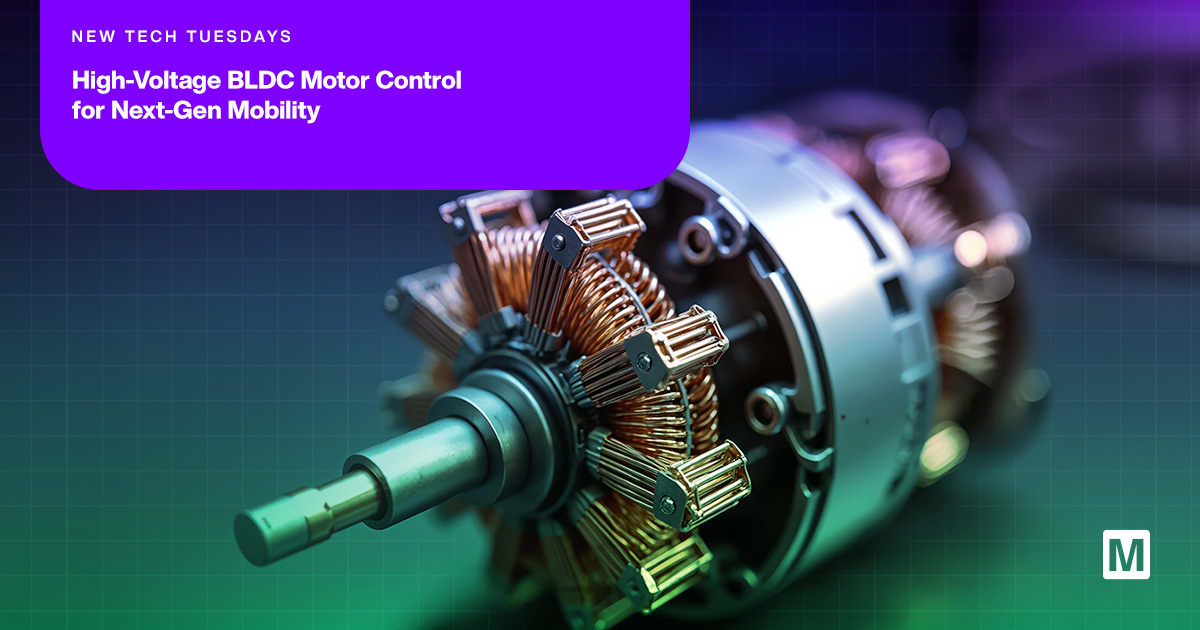High-Voltage BLDC Motor Control for Next-Gen Mobility

New Tech Tuesdays
Join Mouser's Technical Content team for a weekly look at all things interesting, new, and noteworthy for design engineers.
Published November 4, 2025
A modern electric bike (e-bike) can hit approximately 45 kilometers per hour (28 miles per hour) with zero emissions and almost no sound.[1] What makes that possible is not just a bigger battery, but a smarter motor, powered by high-voltage brushless direct current (BLDC) control and tiny, ultra-efficient gate drivers. These compact chips are doing a lot of work behind the scenes, bringing intelligent motion to everything from drones to garden tools.
However, reaching these enhanced levels of speed and performance does not happen with low-voltage systems. To achieve greater torque, longer range, and improved efficiency, engineers are transitioning from traditional 12V and 24V designs to 48V and higher voltages. This week’s New Tech Tuesdays discusses how engineers are making this shift to higher voltages and the benefits to next-generation mobility systems.
High Voltage, High Impact
More and more designs are jumping from 12V or 24V systems to 48V and beyond due to the significant benefits, such as:
- greater torque per amp;
- reduced energy loss and cable thickness; and
- smaller motor footprint and better thermal performance.
Many sectors stand to gain these advantages as motor designs shift to high-voltage BLDC systems. In e-bikes, 48V motors allow for smoother torque modulation, better hill-climbing ability, and improved energy efficiency. Drones benefit from faster electronic speed controller (ESC) response and lighter cabling, which means longer flight times and increased control. Cordless garden tools tap into higher power density, getting closer to gas-like performance without the noise or maintenance (Figure 1). And in light electric vehicles (LEVs), designers can now integrate regenerative braking, increase top-end speed, and optimize battery usage—all while reducing thermal strain on components.

Figure 1: High-voltage BLDC motors in personal mobility and outdoor power tools rely on advanced gate drivers to balance performance, safety, and efficiency. (Source: Annamorphosis/stock.adobe.com; generated with AI)
More Control, Less Complexity
High-voltage BLDC motor control is indeed about power, but precision is also part of the equation. The concept involves pushing that extra current precisely, efficiently, and safely. Integrated gate drivers can simplify this process by combining control logic, fault protection, and gate drive circuitry into a compact integrated circuit (IC), thereby eliminating the need for bulky external components and simplifying the layout.
For example, in a 60V electric hedge trimmer, an integrated gate driver manages motor switching, but also helps prevent shoot-through faults, minimizes heat buildup, and optimizes battery life for extended use. For engineers, that means reduced risk across the entire design cycle.
What’s Next in High-Voltage Motor Design
What used to be a hardware challenge is now just as much a software and systems design problem.
Engineers are implementing techniques like sensorless field-oriented control (FOC) to improve torque response while reducing cost and complexity. At the same time, wide bandgap materials like gallium nitride (GaN) and silicon carbide (SiC) are making high-voltage switching faster and more efficient.[2] But beyond the hardware, features like embedded telemetry and wireless firmware updates are turning motor-driven systems into connected, serviceable platforms that can be useful in drones and LEVs where accessibility is limited.
As new approaches develop to overcome the hardware and software hurdles that come with high-voltage designs, smarter motor control is quickly becoming the baseline for high-performance, compact designs.[3]
The Newest Products for Your Newest Designs®
This week’s New Tech Tuesdays features a product from Qorvo that benefits engineers designing systems that demand high-voltage control with built-in protection and precision.
Qorvo’s ACT72350EVK1 evaluation board is a powerful development platform for high-voltage BLDC motor applications. The ACT72350EVK1 leverages Qorvo’s ACT72350 integrated gate driver, a smart three-phase motor controller that supports up to 160V input voltage and 12V or 15V configurable output voltage. With built-in protection features, precise motor control, and a compact design, the board is ideal for prototyping motor-driven systems like e-bikes, UAVs, robotic tools, and LEVs.
This Qorvo evaluation board brings a host of benefits to motor control designs, including three 160V (180V bootstrap) high-side gate drivers with 2A gate driving capability, three low-side gate drivers with 2A gate driving capability, configurable propagation delay and fault protection, and a pulse-width modulation (PWM) control interface.
Tuesday’s Takeaway
Designing for higher voltage used to mean more complexity. With compact drivers that handle protection, switching, and control in one, it is becoming easier to build efficient, reliable motion systems. Now, engineers can develop mobility technology, tools, or automation with integrated solutions that help them meet tight deadlines without sacrificing precision.
Sources
[1]https://www.gazellebikes.com/en-us/bikes/ebikes/class-3-ebikes
[2]https://www.ti.com/lit/an/slyt801/slyt801.pdf
[3]https://www.powerelectronicsnews.com/power-electronics-advances-on-the-horizon-for-2025/